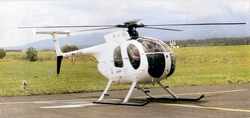Wed, Jan 16, 2013
Worker Suspended Under The Aircraft By A Long Line Fatally Injured When The Helicopter Went Down
The preliminary report issued by the NTSB in an accident involving a Hughes 369 helicopter in Childress, TX last November indicates that the aircraft experienced a "loss of engine power" while a worker was suspended below the aircraft working on a power line. The worker was fatally injured when the aircraft fell. The pilot sustained only minor injuries.

According to the NTSB's preliminary report:
"On November 27, 2012, about 1558 central standard time, a Hughes 369D, N28MP, experienced a loss of engine power during long line powerline construction. The helicopter subsequently impacted terrain during a forced landing near the transmission tower where the work was being performed. The helicopter received substantial damage to the main rotor, fuselage, and tailboom. The commercial pilot sustained minor injuries, and the worker that was attached to the long line was fatally injured. The helicopter was registered to and operated by Brim Equipment Leasing Inc (DBA Brim Aviation) under the provisions of 14 Code of Federal Regulations Part 133 as an external load operations flight. Visual meteorological conditions prevailed for the flight that originated near the accident site about two miles northeast of Childress, Texas."
NTSB investigator Mitchell Gallo told the Amarillo Globe News that the investigation revealed that there were only 20 ounces of fuel on board the helo when it went down. The operating handbook for the Hughes 369 calls for not less than two gallons of fuel. Gallo also said the auxiliary fuel tank was empty.
The NTSB, as always, indicates that the information is preliminary and subject to change, and may contain errors. Any errors in this report will be corrected when the final report has been completed. NTSB investigators either traveled in support of this investigation or conducted a significant amount of investigative work without any travel, and used data obtained from various sources to prepare this aircraft accident report.
(Hughes 369 pictured in file photo. Not accident aircraft)
More News
Back-Taxi A term used by air traffic controllers to taxi an aircraft on the runway opposite to the traffic flow. The aircraft may be instructed to back-taxi to the beginning of the>[...]
“Our WAI members across the nation are grateful for the service and sacrifice of the formidable group of WASP who served so honorably during World War II. This group of brave>[...]
“Many aspiring pilots fall short of their goal due to the cost of flight training, so EAA working with the Ray Foundation helps relieve some of the financial pressure and mak>[...]
Blind Speed The rate of departure or closing of a target relative to the radar antenna at which cancellation of the primary radar target by moving target indicator (MTI) circuits i>[...]
Aero Linx: International Airline Medical Association (IAMA) The International Airline Medical Association, formerly known as the Airline Medical Directors Association (AMDA) was fo>[...]
 ANN's Daily Aero-Term (05.19.24): Back-Taxi
ANN's Daily Aero-Term (05.19.24): Back-Taxi Aero-News: Quote of the Day (05.19.24)
Aero-News: Quote of the Day (05.19.24) Aero-News: Quote of the Day (05.20.24)
Aero-News: Quote of the Day (05.20.24) ANN's Daily Aero-Term (05.20.24): Blind Speed
ANN's Daily Aero-Term (05.20.24): Blind Speed ANN's Daily Aero-Linx (05.20.24)
ANN's Daily Aero-Linx (05.20.24)



